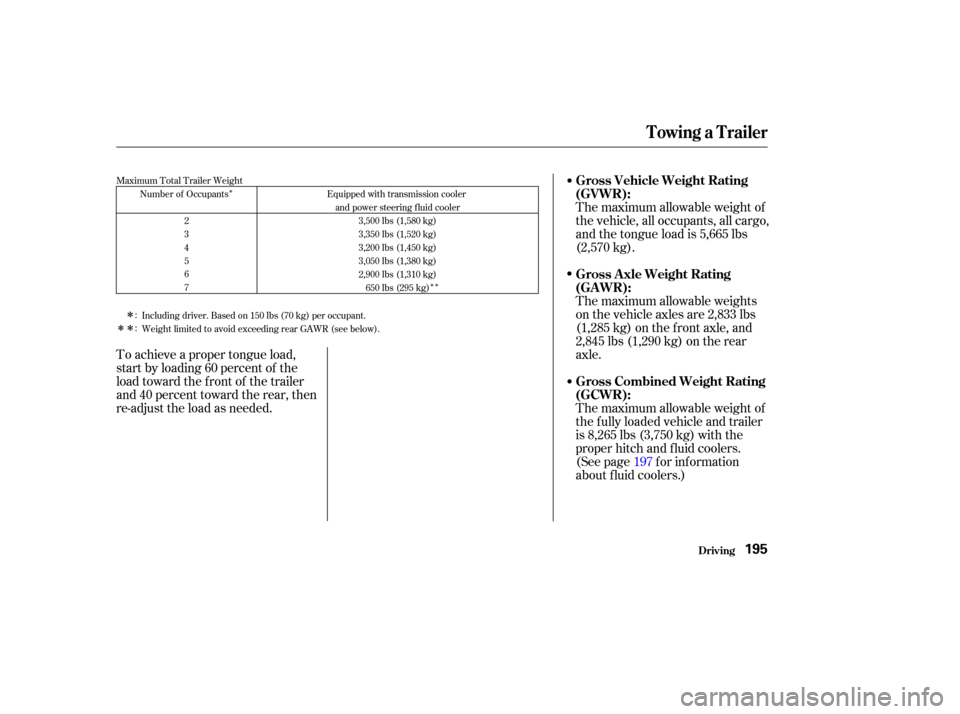Page 164 of 296

Thecruisecontrolmaynotholdthe
set speed when you are going up and
down hills. If your speed increases
going down a hill, use the brakes to
slow down. This will cancel the
cruise control. To resume the set
speed, press the RESUME/accel
button. The CRUISE CONTROL
indicator on the instrument panel will
come back on.
When climbing a steep hill, the
automatic transmission may
downshif t to hold the set speed.You can increase the set cruising
speed in any of these ways:
Push on the accelerator pedal.
Accelerate to the desired cruising
speed and press the SET/decel
button.
To increase your speed in very
small amounts, tap the RESUME/
accel button. Each time you do
this, the vehicle will speed up
about 1 mph (1.6 km/h). You can decrease the set cruising
speed in any of these ways:
Press and hold the SET/decel
button. Release the button when
you reach the desired speed.
To slow down in very small
amounts, tap the SET/decel
button. Each time you do this,
your vehicle will slow down about
1 mph (1.6 km/h).
Tap the brake pedal lightly with
your f oot. The CRUISE
CONTROL indicator on the
instrument panel will go out.
When the vehicle slows to the
desired speed, press the SET/
decel button.
Press and hold the RESUME/
accel button. When you reach the
desired cruising speed, release the
button.
CONT INUED
Cruise Control
Comf ort and Convenience Feat ures
Changing the Set Speed
161
Page 184 of 296
This section gives you tips on
starting the engine under various
conditions, and how to operate the
automatic transmission. It also
includes important inf ormation on
parking your vehicle, the braking
system, the Traction Control System,
and f acts you need if you are
planning to tow a trailer.........................
Preparing to Drive .182
.......................
Starting the Engine .183
..............
Automatic Transmission . 184
..................................
Parking Tips .188
.............................
Braking System .189
...............
Anti-lock Brakes (ABS) . 190
..
Traction Control System (TCS) . 192
...........................
Towing a Trailer .194
Driving
Driving181
Page 187 of 296

These indicators on the instrument
panel show which position the shif t
lever is in.
The ‘‘D’’ indicator comes on f or a
f ew seconds when you turn the
ignition switch to ON (II). If it
f lashes while driving (in any shif t
position), it indicates a possible
problem in the transmission.If the malf unction indicator lamp
comes on along with the ‘‘D’’
indicator, there is a problem in the
automatic transmission control
system. Avoid rapid acceleration and
havethetransmissioncheckedbya
Honda dealer as soon as possible.
To shif t f rom any position, press
f irmly on the brake pedal and pull
the lever towards you. You cannot
shif t out of Park when the ignitionswitch is in the LOCK (0) or
ACCESSORY (I) position.
To shift from:
PtoR
RtoP
NtoR
Dto2 2to1
1to2
2toD
DtoD DtoN
DtoD NtoDRtoN Do this:
Press the brake pedal and
pull the shift lever towards
you.
Pull the shift lever towards
you.
Move the lever.
3
3
3
3
Automatic Transmission
Driving
Shif t L ever Position Indicators
Shif ting
184
SHIFT LEVER
Page 188 of 296

�µ�µ�µ
�µ �µ
�µ
This position mechani-
cally locks the transmission. Use
Park whenever you are turning of f or
starting the engine. To shif t out of
Park, you must press on the brake
pedal and have your f oot of f the
accelerator pedal. Pull the shif t lever
towards you, then move it out of
Park.
If you have done all of the above and
still cannot move the lever out of
Park, see Shif t Lock Release on page .
You must also pull the shif t lever
towards you to shift into Park. To
avoid transmission damage, come to
a complete stop bef ore shif ting into
Park. The shif t lever must be in Park
bef ore you can remove the key f rom
the ignition switch. Press the brake
pedal and pull the shif t lever towards
you to shift from Park to Reverse. To
shif t f rom Reverse to Natural, come
to a complete stop and then shift.
Use Neutral if you
need to restart a stalled engine, or if
it is necessary to stop brief ly with
the engine idling. Shif t to the Park
position if you need to leave your
vehicle for any reason. Press on the
brake pedal when you are moving
the shift lever from Neutral to
another gear.
Use this position f or
normal driving. The transmission
automatically selects a suitable gear
f or your speed and acceleration. You
may notice the transmission shif ting
up at higher speeds when the engine
is cold. This helps the engine warm
up f aster. This position is similar
to D, except only the first three
gears are selected instead of all f ive.
Use D when towing a trailer in hilly
terrain, or to provide engine braking
when going down a steep hill. D can
also keep the transmission f rom
cycling between third and f ourth
gears in stop-and-go driving.
This position locks
the transmission in second gear. It
does not downshif t to f irst gear
when you come to a stop.
Use Second gear: For more power when climbing.
To increase engine braking when
going down steep hills.
For starting out on a slippery
surf ace or in deep snow.
When driving downhill with a
trailer.
186
3
3
CONT INUED
Automatic Transmission
Driving
Park (P) Reverse (R)
Neutral (N)
Drive (D) Drive (D )
Second (2)3
185
Page 189 of 296
�µTo shif t f rom Second to
First, pull the shift lever towards you,
then shift to the lower gear. With the
lever in this position, the
transmission locks in First gear. By
upshif ting and downshif ting through
1, 2, D , and D, you can operate the
transmission much like a manual
transmission without a clutch pedal. If you exceed the maximum speed
f or the gear you are in, the engine
speed will enter into the tachometer’s
red zone. If this occurs, you may f eel
the engine cut in and out. This is
caused by a limiter in the engine’s
computer controls. The engine will
run normally when you reduce the
RPM below the red zone.This allows you to move the shif t
lever out of Park if the normal
method of pushing on the brake
pedal and pulling the shif t lever does
not work.
Set the Parking brake.
Remove the key from the ignition
switch.
1.
2.
3
Automatic Transmission
Driving
First (1)
Engine Speed Limiter Shift Lock Release
186
Page 190 of 296
Place a cloth on the edge of the
Shif t Lock Release slot cover.
Using a small f lat-tipped
screwdriver or a metal f ingernail
f ile, caref ully pry on the edge of
the cover to remove it.Remove the key from the Shift
Lock Release slot, then install the
cover. Press the brake pedal, and
restart the engine.
If you need to use the Shif t Lock
Release, it means your vehicle is
developing a problem. Have it
checked by a Honda dealer.
Insert the key in the Shift Lock
Release slot.
Push down on the key while you
pull the shif t lever towards you
and move it out of Park to Neutral.
5. 6.
4.
3.
Automatic Transmission
Driving187
SHIFT LOCK RELEASE SLOT COVER
Page 191 of 296

Always use the parking brake when
you park your vehicle. Make sure
the parking brake is set f irmly or
your vehicle may roll if it is parked
on an incline.
Set the parking brake bef ore you put
the transmission in Park. This keeps
the vehicle from moving and putting
pressure on the parking mechanism
in the transmission.Make sure the windows are closed.
Turn of f the lights.
Place any packages, valuables, etc.
in the cargo area, or take them
with you.
Lock the doors and the tailgate.
Never park over dry leaves, tall
grass, or other f lammable
materials. The hot three way
catalytic converter could cause
these materials to catch on fire.If the vehicle is f acing uphill, turn
the f ront wheels away f rom the
curb.
If the vehicle is f acing downhill,
turn the front wheels toward the
curb.
Make sure the parking brake is
f ully released bef ore driving away.
Driving with the parking brake
partially set can overheat or
damage the rear brakes.
Driving
Parking T ips
Parking T ips
188
Page 198 of 296

�Î�Î
�Î
�Î
��ΠIncluding driver. Based on 150 lbs (70 kg) per occupant.
Weight limited to avoid exceeding rear GAWR (see below). Equipped with transmission cooler
and power steering fluid cooler 3,500 lbs (1,580 kg)
3,350 lbs (1,520 kg)
3,200 lbs (1,450 kg)
3,050 lbs (1,380 kg)
2,900 lbs (1,310 kg)650 lbs (295 kg)
Maximum Total Trailer Weight
Number of Occupants
2
3
4
5
6
7
:
:
To achieve a proper tongue load,
start by loading 60 percent of the
load toward the front of the trailer
and 40 percent toward the rear, then
re-adjust the load as needed. The maximum allowable weight of
the vehicle, all occupants, all cargo,
and the tongue load is 5,665 lbs
(2,570 kg).
The maximum allowable weights
on the vehicle axles are 2,833 lbs
(1,285 kg) on the f ront axle, and
2,845 lbs (1,290 kg) on the rear
axle.
The maximum allowable weight of
the f ully loaded vehicle and trailer
is 8,265 lbs (3,750 kg) with the
proper hitch and f luid coolers.
(See page f or inf ormation
about f luid coolers.)
197
Towing a Trailer
Driving
Gross Vehicle Weight Rating
(GVWR):
Gross Axle Weight Rating
(GA WR):
Gross Combined Weight Rating
(GCWR):
195